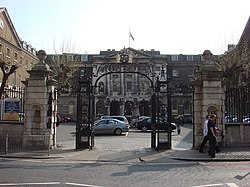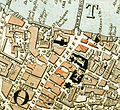
GKT School of Medical Education is the medical school of King's College London. The school has campuses at three institutions, Guy's Hospital (Southwark), King's College Hospital and St Thomas' Hospital (Lambeth) in London – with the initial of each hospital making up the acronymous name of the school. The school in its current guise was formed following a merger with the United Medical and Dental Schools of Guy's and St Thomas' Hospitals on 1 August 1998. As of 2023, the medical school is ranked 5th best in the UK for clinical medicine by U.S. News & World Report, and 10th best worldwide by Times Higher Education.

King's College London is a public research university located in London, England. King's was established by royal charter in 1829 under the patronage of King George IV and the Duke of Wellington. In 1836, King's became one of the two founding colleges of the University of London. It is one of the oldest university-level institutions in England. In the late 20th century, King's grew through a series of mergers, including with Queen Elizabeth College and Chelsea College of Science and Technology, the Institute of Psychiatry, the United Medical and Dental Schools of Guy's and St Thomas' Hospitals and the Florence Nightingale School of Nursing and Midwifery.

St Thomas' Hospital is a large NHS teaching hospital in Central London, England. It is one of the institutions that compose the King's Health Partners, an academic health science centre. Administratively part of the Guy's and St Thomas' NHS Foundation Trust, together with Guy's Hospital, King's College Hospital, University Hospital Lewisham, and Queen Elizabeth Hospital, it provides the location of the King's College London GKT School of Medical Education.
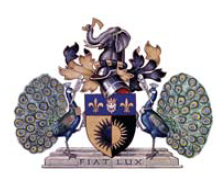
Moorfields Eye Hospital is a specialist National Health Service (NHS) eye hospital in Finsbury in the London Borough of Islington in London, England run by Moorfields Eye Hospital NHS Foundation Trust. Together with the UCL Institute of Ophthalmology, which is adjacent to the hospital, it is the oldest and largest centre for ophthalmic treatment, teaching and research in Europe.

King's College Hospital is a major teaching hospital and major trauma centre in Denmark Hill, Camberwell in the London Borough of Lambeth, referred to locally and by staff simply as "King's" or abbreviated internally to "KCH". It is managed by King's College Hospital NHS Foundation Trust. It serves an inner city population of 700,000 in the London boroughs of Southwark and Lambeth, but also serves as a tertiary referral centre in certain specialties to millions of people in southern England. It is a large teaching hospital and is, with Guy's Hospital and St. Thomas' Hospital, the location of King's College London School of Medicine and one of the institutions that comprise the King's Health Partners, an academic health science centre. The chief executive is Dr Clive Kay. It is also the birthplace of Queen Camilla.

The Royal London Hospital is a large teaching hospital in Whitechapel in the London Borough of Tower Hamlets. It is part of Barts Health NHS Trust. It provides district general hospital services for the City of London and Tower Hamlets and specialist tertiary care services for patients from across London and elsewhere. The current hospital building has 845 beds and 34 wards. It opened in February 2012.
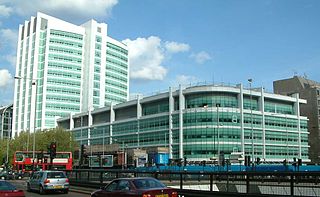
University College Hospital (UCH) is a teaching hospital in the Fitzrovia area of the London Borough of Camden, England. The hospital, which was founded as the North London Hospital in 1834, is closely associated with University College London (UCL), whose main campus is situated next door. The hospital is part of the University College London Hospitals NHS Foundation Trust.

St Mary's Hospital is an NHS hospital in Paddington, in the City of Westminster, London, founded in 1845. Since the UK's first academic health science centre was created in 2008, it has been operated by Imperial College Healthcare NHS Trust, which also operates Charing Cross Hospital, Hammersmith Hospital, Queen Charlotte's and Chelsea Hospital and the Western Eye Hospital.

St George's Hospital is a large teaching hospital in Tooting, London. Founded in 1733, it is one of the UK's largest teaching hospitals and one of the largest hospitals in Europe. It is run by the St George's University Hospitals NHS Foundation Trust. It shares its main hospital site in Tooting in the London Borough of Wandsworth, with St George's, University of London, which trains NHS staff and carries out advanced medical research.
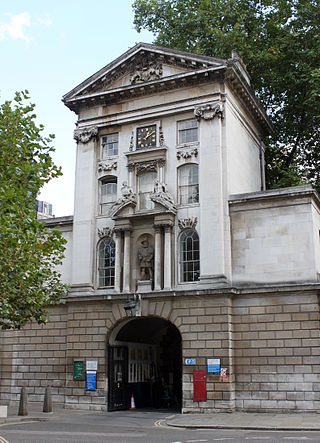
St Bartholomew's Hospital, commonly known as Barts, is a teaching hospital located in the City of London. It was founded in 1123 by Rahere, and is currently run by Barts Health NHS Trust.
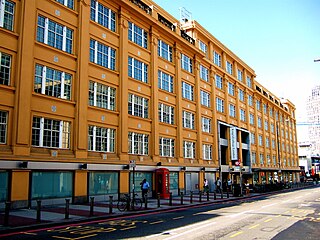
The Florence Nightingale Faculty of Nursing, Midwifery & Palliative Care is an academic faculty within King's College London. The faculty is the world's first nursing school to be continuously connected to a fully serving hospital and medical school. Established on 9 July 1860 by Florence Nightingale, the founder of modern nursing, it was a model for many similar training schools through the UK, Commonwealth and other countries for the latter half of the 19th century. It is primarily concerned with the education of people to become nurses and midwives. It also carries out nursing research, continuing professional development and postgraduate programmes. The Faculty forms part of the Waterloo campus on the South Bank of the River Thames and is now one of the largest faculties in the university.

The Royal National Orthopaedic Hospital (RNOH) is a specialist orthopaedic hospital located in Stanmore in the London Borough of Harrow, run by the Royal National Orthopaedic Hospital NHS Trust. It provides the most comprehensive range of neuro-musculoskeletal health care in the UK, including acute spinal injury, complex bone tumour treatment, orthopaedic medicine and specialist rehabilitation for chronic back pain. The RNOH is a major teaching centre and around 20% of orthopaedic surgeons in the UK receive training there.

Royal Brompton Hospital is the largest specialist heart and lung medical centre in the United Kingdom. It is managed by Guy's and St Thomas' NHS Foundation Trust.
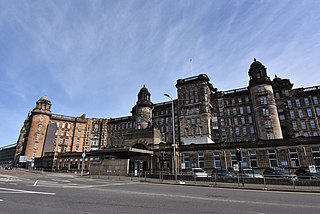
The Glasgow Royal Infirmary (GRI) is a large teaching hospital. With a capacity of around 1,000 beds, the hospital campus covers an area of around 8 hectares, and straddles the Townhead and Dennistoun districts on the north-eastern fringe of the city centre of Glasgow, Scotland. It is managed by NHS Greater Glasgow and Clyde. It was originally opened in 1794, with the present main building dating from 1914.

The Bristol Royal Infirmary, also known as the BRI, is a large teaching hospital in the centre of Bristol, England. It has links with the nearby University of Bristol and the Faculty of Health and Social Care at the University of the West of England, also in Bristol.
The Seafarers Hospital Society, formerly the Seamen's Hospital Society, is a charity for people currently or previously employed by the British Merchant Navy and fishing fleets, and their families. It was established in 1821.

The London Chest Hospital, located in Bethnal Green in London, adjacent to Victoria Park, was a hospital with a national reputation for treatment of cardiac and pulmonary disease. Since 1999 it had been run by the Barts Health NHS Trust. It closed on 17 April 2015 as part of the creation of the Barts Heart Centre at St Bartholomew's Hospital, by consolidation of services from the London Chest Hospital and The Heart Hospital, part of University College London Hospital.
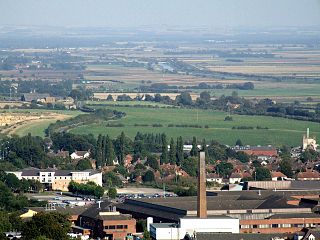
Lincoln County Hospital is a large district general hospital on the eastern edge of north-east Lincoln, England. It is the largest hospital in Lincolnshire, and offers the most comprehensive services, in Lincolnshire. It is managed by the United Lincolnshire Hospitals NHS Trust.

The Metropolitan Free Hospital was a London hospital, founded in 1836 and based for most of its existence in Kingsland Road, Hackney. It became part of the NHS in 1948, and closed in 1977, with its residual functions transferring to Barts Hospital.
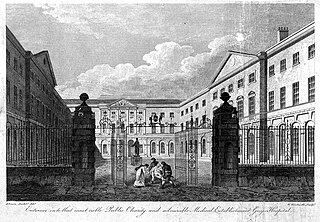
Guy's Campus is a campus of King's College London adjacent to Guy's Hospital and situated close to London Bridge and the Shard, on the South Bank of the River Thames in London. It is home to the Faculty of Life Sciences & Medicine and the Dental Institute.
